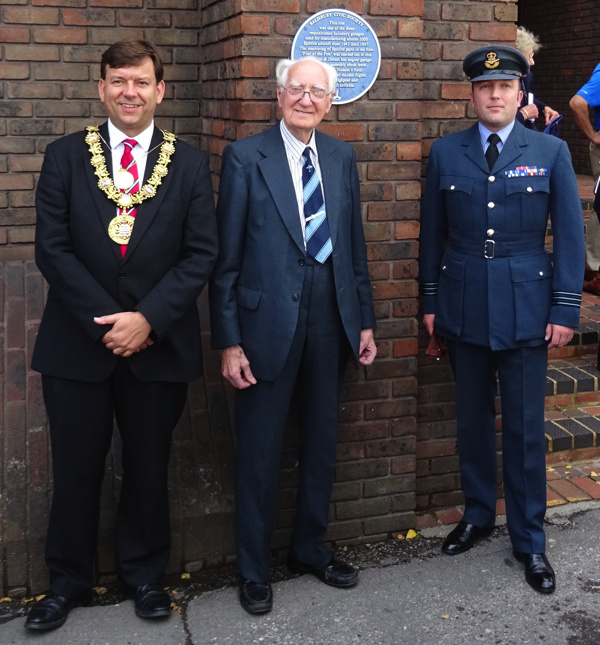
Plaque number 103 can be found at this location.
This plaque can be found at 141 Castle Street.
This building was built for CoSIRA (Council for Small Industries in Rural Areas).
When the plaque was unveiled it was occupied by CAPITA.
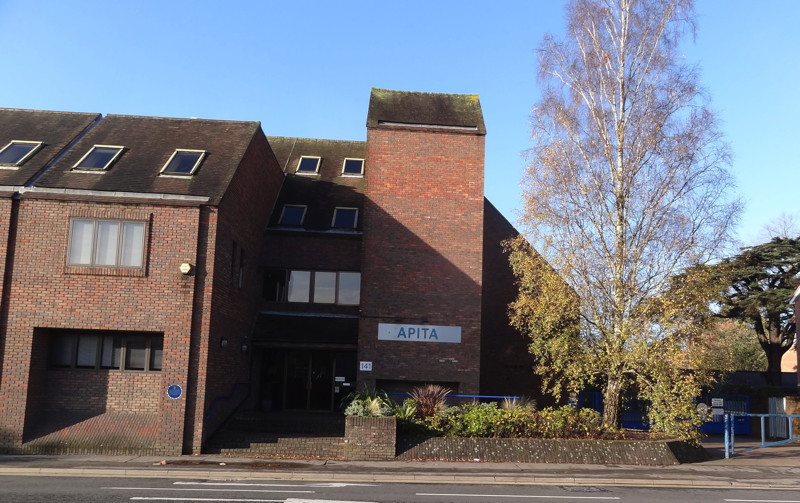
The O/S grid position is SU ????? East ????? North
Salisbury Civic Society
This site
was one of the three
requisitioned Salisbury garages
used for manufacturing almost 2000
Spitfire aircraft from 1941 until 1947.
The machining of Spitfire parts in the film
'First of the Few' was carried out in this
former Wilts & Dorset bus engine garage.
Two Spitfire assembly sheds were constructed on Hudson’s field.
Final assembly and maiden flights
were from Highpost and
Chattis Hill airfields.

On Tuesday 15th September 2015 the Salisbury Spitfire Production plaque was unveiled by Norman Parker, an 89 year old engineer who worked on the Spitfire production at High Post. He is flanked on his right by Salisbury's Mayor, Andrew Roberts and on his left by Wing Commander James Ankers (Air Warfare Centre Chief Air Engineer, Boscombe Down). Amongst many others present were General Sir Jack Devrell, Deputy Lord Lieutenant of Wiltshire and the Salisbury Civic Society chairman, Peter Dunbar.

Afterwards Norman Parker made a speech in the CAPITA conference suite. He went through the details of Spitfire production in Salisbury with a multitude of photographs.
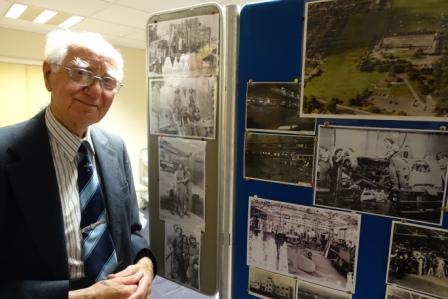
Tea and cake was provided by CAPITA who also allowed guests to go out onto their balcony, overlooking the river avon.
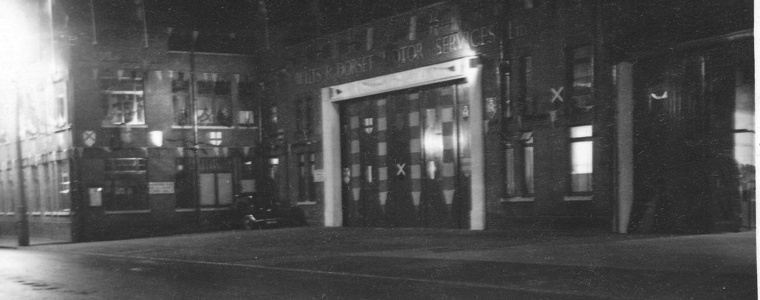
Wilts & Dorset bus garage at night. Two sets of two large garage doors.
Essen, Enfield, Brno, Toledo and Springfield might be included in any list of cities associated with the arms trade, but Salisbury? During World War II many normally peaceable communities suddenly found themselves doing war work; overnight the ploughshare makers became sword smiths. This is exactly where Salisbury found itself in 1940.
In response to the threat posed by German expansionism during the 1930s, the British government decided to reinforce and re-equip the RAF. Initially the bomber force was the priority, as strategists advised that ‘the bomber will always get through’. However by the end of the decade faster fighters had entered service which had a better chance of catching the bombers, and so priorities were changed.
From the beginning of the RAF expansion, ministers had encouraged manufacturers to sub contract work and disperse production as widely as possible so that the bombing of a few key factories would not seriously disrupt it. The main problem was that many British aircraft builders were small businesses and unused to mass production. It had taken an acknowledged master of production techniques (Lord Nuffield - William Morris of Morris Motors) to get the initial expansion scheme going. All types of premises were requisitioned – warehouses, garages, even laundries. By the outbreak of war, 65 factories had been set up throughout southern England organised into area dispersal schemes. Salisbury was part of the Southampton scheme.
Among the machines these factories were building, was one which the public took to their hearts, R J Mitchell’s Spitfire. For a start, its elliptical wing made it easy to recognise and the flat growl of its engine proclaimed it ‘one of ours’. Second, even before the Battle of Britain, this fighter had come to represent some of the qualities the British regarded as their own - defiance, courage in the face of odds, and invincibility. Maintaining the supply of Spitfires was therefore not just a matter of strategy, but also of national morale.
Imagine, then, Lord Beaverbrook's horror when, on appointment as Minister of Aircraft Production in 1940, he discovered that Spitfire production was still centred on two small factories in Southampton. A further round of dispersals was needed, and it was this that brought Spitfire building to Salisbury.
The Spitfire was difficult to produce in large numbers. It took a lot of work to coax metal into the compound curves which characterise this beautiful aeroplane. A good example here is the aerodynamically efficient fillet which takes the wing root into the oval fuselage. The wing itself was complex, many of the flight loads being taken by the D-section leading edge which was built separately.
It took RJ Mitchell’s deputy (and successor) Joseph Smith two years to adapt the whole design to the needs of mass production.
The essence of dispersal was that components were manufactured at separate locations and then assembled centrally. Standards had to be maintained by training and inspection to ensure that everything fitted together. Readers who have assembled flat pack furniture will be familiar with this problem. Working methods had to be coordinated and the accuracy of jigs checked. Most of the labour force was recruited locally, but specialists and trainers had to be imported, housed and fed. The managers seemed to have been surprised by the speed and enthusiasm of the 45% female workforce. At one stage, aircraft were being made faster than pilots could be found to test them. A rumour went round (and was widely believed} that unpiloted Spitfires were being tethered to a post in what would have been an enormous merry-go-round. There was of course not a word of truth in this, but it illustrates the power of rumour in wartime.
It is a testimony to the brilliance of R J Mitchell’s design that the basic airframe was capable of many different roles - local defence fighter, high altitude reconnaissance, medium range escort fighter (with external fuel tanks), fighter–bomber, and naval fleet fighter. It served in almost all theatres of war, and was finally withdrawn from British and Commonwealth service in 1953. There were 24 Marks of Spitfire, and 47 of the naval version - Seafire. Few indeed are the aircraft that can show so long and effective a service record. For the workforce, it entailed frequent job changes. Over the years, areas came to specialise in a limited range of Marks. Salisbury concentrated on Marks V, IX, XII and Seafires. Of all the marks, the Mark 5 was produced in the greatest numbers. In all, some 27,000 Spitfires were built, to which the Southampton scheme contributed 8,000. Salisbury produced around 2000. The generation that did this should feel proud of itself.
And so, less than a mile from the Cathedral, thousands of aircraft were being built in clandestine factories. Did the Germans have any inkling of this? Almost certainly. But they would have had several reasons not to bomb Salisbury, not the least being that, in the days of visual ‘head over the side’ navigation, landmarks like the Cathedral were precious.
The story of the Salisbury Spitfires is one of ordinary people doing extraordinary things. Many of those recruited to the scheme had probably never touched an aeroplane before, and had never imagined that they would work in anything as exotic as aviation. Yet after what must have been the barest minimum of training, they were building fighters faster than they could be flown away. Amazing.
Spitfire – the history E Morgan and E Shacklady Guild Publishing London 1987
The Battle of Britain – James Holland
The Battle of Britain - J T Bickers Guild Publishing London 1990
Spitfire – the Combat History Robert Jackson Airlife Shrewsbury 1995
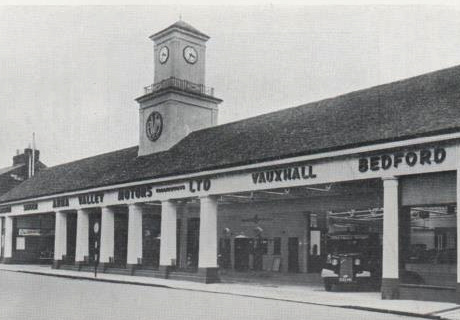
Anna Valley Motors garage in Castle Street, opposite side to the river.
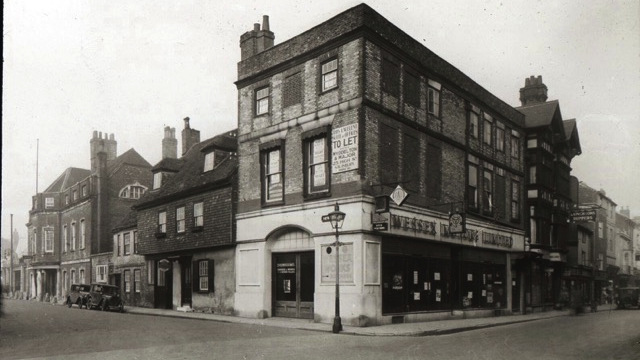
Wessex garage at the corner of New Street and Catherine Street, not far from the Cathedral!
Click here to go back to Salisbury Plaques Home Page
Click here to go to the Salisbury Civic Society's Home Page.
Click here to check validation.